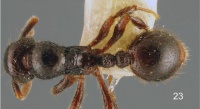Lordomyrma diwata
| Lordomyrma diwata | |
|---|---|

| |
| Scientific classification | |
| Kingdom: | Animalia |
| Phylum: | Arthropoda |
| Class: | Insecta |
| Order: | Hymenoptera |
| Family: | Formicidae |
| Subfamily: | Myrmicinae |
| Tribe: | Crematogastrini |
| Genus: | Lordomyrma |
| Species: | L. diwata |
| Binomial name | |
| Lordomyrma diwata Taylor, 2012 | |
Sympatric on Mt Isarog with Lordomyrma emarginata and Lordomyrma idianale.
Identification
Taylor (2012) - The generally smooth sculpturation readily distinguishes L. diwata from other known Philippines and Asian Lordomyrma species.
Keys including this Species
Distribution
Latitudinal Distribution Pattern
Latitudinal Range: 13.74111111° to 13.74111111°.
| North Temperate |
North Subtropical |
Tropical | South Subtropical |
South Temperate |
- Source: AntMaps
Distribution based on Regional Taxon Lists
Indo-Australian Region: Philippines (type locality).
Distribution based on AntMaps
Distribution based on AntWeb specimens
Check data from AntWeb
Countries Occupied
| Number of countries occupied by this species based on AntWiki Regional Taxon Lists. In general, fewer countries occupied indicates a narrower range, while more countries indicates a more widespread species. |

|
Estimated Abundance
| Relative abundance based on number of AntMaps records per species (this species within the purple bar). Fewer records (to the left) indicates a less abundant/encountered species while more records (to the right) indicates more abundant/encountered species. |

|
Biology
Castes
Known only from the worker caste.
Nomenclature
The following information is derived from Barry Bolton's Online Catalogue of the Ants of the World.
- diwata. Lordomyrma diwata Taylor, 2012: 54, figs. 21-24 (w.) PHILIPPINES (Luzon).
Unless otherwise noted the text for the remainder of this section is reported from the publication that includes the original description.
Description
Worker
General features as seen in images. Conformation similar to Lordomyrma azumai; vertexal margin broadly rounded in frontal view. Mesosoma proportionately short, its promesonotal profile more elevated and more evenly arched than in azumai. Promesonotal shoulders in dorsal view more evenly rounded, lacking nodules equivalent to those of L. azumai. Antennal scapes as in L. azumai. A generally shining species with sculpturation relatively reduced and reflective. Mandibles and clypeus smooth and shining, the former with a few scattered piligerous point-punctures. Frons anteromedially and behind smooth and strongly shining, with a band of vestigial longitudinal striate-rugosity on each side to beyond the level of the eyes. Sides of head coarsely punctate-rugose. Head ventrally smooth and shining. Antennal foveae generally smooth, strongly reflective, with very faint vestiges of fine shagreening near the antennal insertions. Occipital collar smooth behind, anterior section weakly shagreened. Promesonotal dorsum smooth, highly reflective with a few scattered piligerous punctae, more dense laterally. Propodeal dorsum moderately rugose, the declivity smooth and shining, without transverse striae between the spines. Sides of mesosoma behind pronotum moderately coarsely rugose but shining. Petiole anterodorsally smooth and shining, elsewhere punctate-rugose. Postpetiole similarly punctate-rugose. Gaster dorsally smooth and shining with scattered small piligerous point-punctures and a band of minute microreticulation behind; ventrally shining, with somewhat effaced dense moderate puncturation. Antennal funiculi densely, minutely punctate. Anterior coxae smooth, strongly reflective; middle and hind coxae with trace transverse striae; legs otherwise smooth with a few scattered punctae and traces of shagreening at the femoral bases. Pilosity as seen in images. Color generally dark mahogany-brown, the antennae and legs lighter brown. Dimensions: (Holotype, smallest paratype, largest paratype): TL 3.2, 2.8, 3.4; HW 0.74, 0.70, 0.75; HL 0.77, 0.72, 0.78; CI 96, 97, 96; EL 0.15, 0.15, 0.16; OI 20, 21, 21; SL 0.51, 0.49, 0.53; SI 69, 70, 71; PW 0.54, 0.50, 0.0.57; WL 0.96, 0.94, 1.02; DPW 0.20, 0.20, 0.22; DPpW 0.25, 0.24, 0.26; GW 0.73, 0.72, 0.75.
Type Material
PHILIPPINES: LUZON: Mt Isarog National Park, Panicuason Village, Camarines Sur (13°39 28.5’N, 123°20 11.2’E). Known from the holotype and 8 paratype workers collected at the type locality (J. Caceres, 23 or 24-x-2006, ex leaf litter). Holotype, 2 paratypes: University of the Philippines Los Baños. Single paratypes in Australian National Insect Collection, The Natural History Museum, DMGC, Los Angeles County Museum of Natural History, Museum of Comparative Zoology, PNMM.
Etymology
Diwata are mythical forest nymphs in Philippines folklore.
Determination Clarifications
This is the taxon designated Lordomyrma PH02 by Lucky & Sarnat (2010).
References
- General, D.E.M., Buenavente, P.A.C., Rodriguez, L.J.V. 2020. A preliminary survey of nocturnal ants, with novel modifications for collecting nocturnal arboreal ants. Halteres 11: 1-12 (doi:10.5281/ZENODO.3707151).
- Liu, X., Xu. Z., Hita Garcia, F. 2021. Taxonomic review of the ant genus Lordomyrma Emery, 1897 (Hymenoptera, Formicidae) from China, with description of two new species and an identification key to the known species of the world. Asian Myrmecology 14: e014007 (doi:10.20362/am.014007).
- Taylor, R.W. 2012. Ants of the genus Lordomyrma Emery (2) The Japanese L. azumai (Santschi) and six new species from India, Vietnam and the Philippines. Zootaxa 3282:45-60.
References based on Global Ant Biodiversity Informatics
- Taylor R. W. 2012. Ants of the genus Lordomyrma Emery (2) The Japanese L. azumai (Santschi) and six new species from India, Viet Nam and the Philippines (Hymenoptera: Formicidae: Myrmicinae). Zootaxa 3282:45-60.

